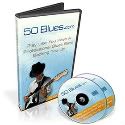Economy picking is a monster of a technique that will allow you to play licks faster and with less effort than alternate picking once you master it. Many also refer to it as speed picking, a phrase coined by Frank Gambale who is credited with the invention of this technique. It is basically a combination of alternate and sweep picking.
For example, if the first note is on the fifth string, and the next note is on the fourth string, the pick will use a downstroke on the fifth string, and continue in the same direction to a downstroke on the fourth string.
Economy picking lends itself well to three note per string scales. Allow me to illustrate. If you begin a three note per string scale like the one I have shown below using an alternate pattern you will notice that after down picking the third note you would then be crossing over the next string in order to up stroke the next note. That's a lot of extra movement if you think about it.
Economy picking eliminates this unnecessary movement by down picking from the third to the fourth note in the scale. The resulting picking pattern is down-up-down-down-up-down-down-up etc.
To summarize: economy picking involves using alternate picking except when changing strings. Then you incorporate a mini sweep in the direction of the next note.
Although economy picking lends itself well to three note per string licks and scales, it can be applied to many situations. Basically, whenever you have just played a down stroke and the next note is on the string below just keep going down and then resume the alternate pattern. The same holds true if you use an up stroke and the next note falls on the string above.
A good way to start getting your pick hand used to this motion, and believe me it is awkward at first, is to play just the open strings on your electric guitar. Starting on the sixth string, play three notes per string using a down-up-down-down-up-down-down-up pattern. Play up to the first string and then back down to the sixth using an up-down-up-up-down-up-up-down pattern. When this becomes more familiar to you go ahead and practice it with three note scale patterns like the major scale below.
The economy picking technique sounds as though it would require more conscious thought to execute, but many guitarists learn it intuitively and find it an effort to use alternate picking. I personally found it rather difficult an in some situations prefer alternate picking, but don't let that discourage you from attempting to tackle this beast. I have seen what it can do and it is pretty amazing. If you would like to hear what applying this technique to your playing might sound like I strongly suggest you listen to Frank Gambale the father of economy picking, or speed picking as he refers to it.Here is the three note per string G major scale mentioned above.










